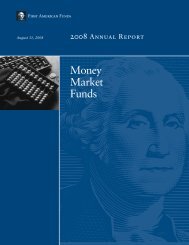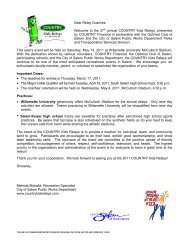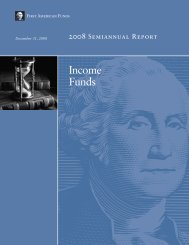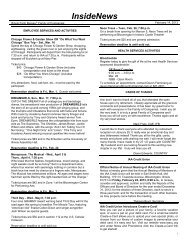Prospectus - COUNTRY Financial
Prospectus - COUNTRY Financial
Prospectus - COUNTRY Financial
- No tags were found...
Create successful ePaper yourself
Turn your PDF publications into a flip-book with our unique Google optimized e-Paper software.
Bond FUNDInvestment GoalMaximum total return consistent with preservation of capital.Principal StrategyTo pursue its goal, the Fund invests in a portfolio of bonds andother debt obligations (debentures, notes, mortgage-backed andasset-backed) and maintains a market value weighted averagematurity of more than five years. Under normal conditions, theFund invests at least 80% of assets in the following:• debt obligations of corporations which are rated within thetop three rating categories by independent rating agencies orin non-rated equivalents• securities issued by the U.S. Government or its agencies orinstrumentalities• obligations of international agencies and U.S. dollardenominated foreign debt securities which are rated withinthe top three rating categories by independent rating agenciesor in non-rated equivalentsAt least 80% of the value of the Fund’s net assets will beinvested in bonds (U.S. Government, corporate and convertibleissues). The Fund may invest up to 20% of its net assets incorporate bonds which are rated below the top three ratingcategories. On occasion, up to 20% of the Fund’s net assetsmay be invested in commercial paper within the two highestrating categories of independent rating agencies. The Fund mayinvest up to 10% of its assets in securities of foreign issuers.The Fund may also invest in zero coupon U.S. Governmentsecurities.In managing its portfolio, the portfolio manager attempts tobalance sensitivity to interest rate movements with the potentialfor yields. The Fund invests in securities of longer-termmaturities in order to obtain higher yields. Securities withlonger maturities, however, tend to be more sensitive to interestrate changes.Important RisksThere are risks involved with any investment, but the risksassociated with an investment in the Fund include:• risk that the value of the securities the Fund holds will fall asa result of changes in interest rates, an issuer’s actual orperceived creditworthiness or an issuer’s ability to meet itsobligations• call risk or the risk that a bond might be called or forciblyredeemed during a period of declining interest rates• the longer the average maturity of the bonds in the Fund, themore the Fund’s share price will fluctuate in response tointerest rate changes: if interest rates rise, the value of thebonds will fall• the Fund could lose money if any bonds it owns aredowngraded in credit rating or go into default• in some instances, when interest rates fall, mortgage-backedsecurities may incur prepayments which could adverselyaffect performance if the Fund is unable to reinvest at thehigher interest rates• when interest rates rise, mortgage- and asset-backed securitiesmay extend duration due to lower than projectedprepayments which could adversely affect investment returns• the risk of losing your money (investment)• foreign securities risks, including currency, natural event andpolitical risksSuitabilityThe Fund may be a suitable investment for you if you seek:• a relatively conservative investment for income• a bond fund that invests in both corporate and U.S.Government securities• a fund to complement a portfolio of more aggressiveinvestmentsYou should not consider this Fund if you are seeking highgrowth or maximum income or are investing emergency reservemoney.Bar Chart and Performance TableThe following bar chart provides some indication of the risks ofinvesting in the Fund’s Class Y shares (the class of shares withthe longest period of annual returns) by showing changes in theFund’s performance from year to year. Class A shares wouldhave substantially similar annual returns because both classes ofshares will be invested in the same portfolio of securities.Annual returns will differ only to the extent that the classes donot have the same expenses. The bar chart includes the effectsof the Fund’s expenses, but not sales charges. If sales chargeswere included the returns would be lower. The performancetable shows how the Fund’s average annual returns comparewith those of a broad measure of market performance. Boththe bar chart and table assume reinvestment of dividends anddistributions. As with all mutual funds, past performance(before and after-taxes) is not a prediction of futureperformance and the bar chart does not reflect the deduction oftaxes that a shareholder would pay on Fund distributions or theredemption of Fund shares.4












